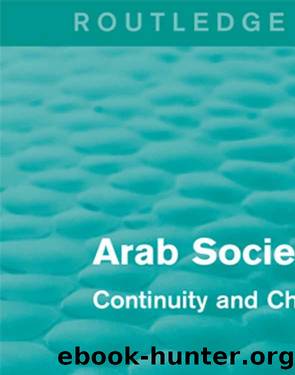Arab Society by Samih K. Farsoun

Author:Samih K. Farsoun
Language: eng
Format: epub
Publisher: Routledge
5 ISLAMIC REVIVAL IN THE MIDDLE EAST: A COMPARISON OF IRAN AND EGYPT
Nikki R. Keddie
Modern Islamic Revivalism and Secularism: A Comparative Approach
Islamic revivalist movements in the past two centuries have largely been militantly political movements, usually directed against Western conquest, colonisation, or interference in Muslim lands. The dramatic revivalist movements of the last few years, most notably in Iran, contain novel features, but they are not completely new phenomena. They contrast sharply with the rather pro-Western Muslim liberalism typified by Muhammad Abduh and his mainly middle- or upper-class followers, the Muslim liberalism that was long the centre of attention for Western writers on recent Islam. Islamic revivalism has more affinity to Muslim movements less concerned to liberalise Islam on a Western model than to save Muslim peoples from the physical and religio-cultural encroachments of the West.
While movements in eighteenth-century Arabia and India have certain affinities to later Islamic revivalism, I will here begin with the nineteenth century, when Western conquests in the Middle East began and when the Industrial Revolution and the resultant change in the character of world trade and production greatly increased the impact of the West on the Middle East. While the entry of Western goods in increased amounts and the consequent harm to Middle Eastern handicrafts brought some protests against the West, a true militant and military revivalism, largely in the name of defending Islam, came only in the face of actual Western military conquests and attempts to extend them. Interestingly, the early examples (‘early’ in terms of the major Western encroachments) of military-political resistance were tied to (‘Sufi’) religious orders with a large popular base. (The Western term ‘Sufi order’ is misleading, as it conjures up a picture of other-wordly mystics. Many tariqas — ‘orders’ or ‘religious orders’ minus the ‘Sufi’ might be the best translation — were societies with a variety of social, economic, political and religious purposes in which mysticism might play little or no part.)
There is no space to detail tariqa-related resistance to Western encroachments, which included a defence of Islam and some revivalist ideology, but three major examples of it may be mentioned: that of Abdel Qader and his followers in Algeria against the French, that of Shamyl in the Caucasus against the Russians, and that of the Sanusis of Libya against the Italians. To some degree the Mahdist movement of the Sudan in the 1880s and 1890s fits the pattern, as it appealed to a tariqa, even though it was distinguished by a messianic ideology and only partly directed against Europeans. According to Peter Holt, the main socio-economic change encouraging the Mahdist movement was the end of the slave trade, with the economic difficulties this brought in the Sudan, and this was a direct result of Western presence and influence.1
All the above movements were, after decades of struggle, defeated, and this is probably one reason they have not been given the attention they merit in histories of the Middle East. They may be seen in a sense as archaic, but
Download
This site does not store any files on its server. We only index and link to content provided by other sites. Please contact the content providers to delete copyright contents if any and email us, we'll remove relevant links or contents immediately.
International Integration of the Brazilian Economy by Elias C. Grivoyannis(74659)
The Radium Girls by Kate Moore(11619)
Turbulence by E. J. Noyes(7700)
Nudge - Improving Decisions about Health, Wealth, and Happiness by Thaler Sunstein(7242)
The Black Swan by Nassim Nicholas Taleb(6762)
Rich Dad Poor Dad by Robert T. Kiyosaki(6174)
Pioneering Portfolio Management by David F. Swensen(6078)
Man-made Catastrophes and Risk Information Concealment by Dmitry Chernov & Didier Sornette(5646)
Zero to One by Peter Thiel(5488)
Secrecy World by Jake Bernstein(4388)
Millionaire: The Philanderer, Gambler, and Duelist Who Invented Modern Finance by Janet Gleeson(4093)
The Age of Surveillance Capitalism by Shoshana Zuboff(3983)
Skin in the Game by Nassim Nicholas Taleb(3965)
The Money Culture by Michael Lewis(3846)
Bullshit Jobs by David Graeber(3828)
Skin in the Game: Hidden Asymmetries in Daily Life by Nassim Nicholas Taleb(3720)
The Dhandho Investor by Mohnish Pabrai(3560)
The Wisdom of Finance by Mihir Desai(3523)
Blockchain Basics by Daniel Drescher(3329)
